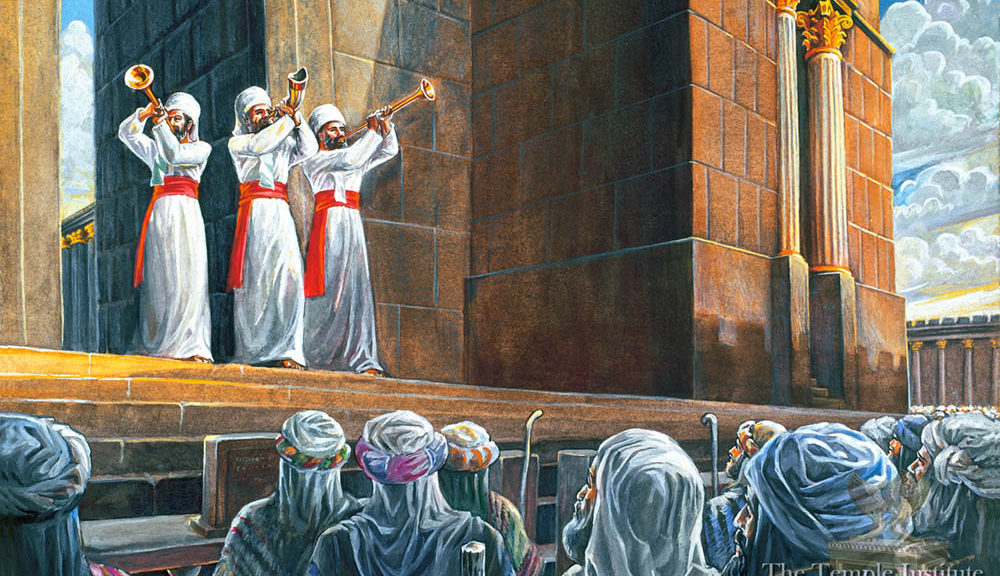From Jerusalem, Israel’s eternal unified capital — We send everyone prayers for a Shana Tova! A sweet New Year filled with blessings of health, happiness and closeness. This past half a year has been challenging and we look forward to better, smoother days ahead, filled with peace!
This article explains the significance of Rosh Hashana in Jerusalem…
Photo Courtesy: The Temple Institute
The Holy Temple: Rosh Hashana
Article Courtesy: The Temple Institute
“And in the seventh month, on the first day of the month, you shall have a holy convocation: you shall do no manner of servile work; it is a day of blowing the horn unto you. And you shall prepare a burnt-offering for a sweet savour unto HaShem: one young bullock, one ram, seven he-lambs of the first year without blemish; and their meal-offering, fine flour mingled with oil, three tenth parts for the bullock, two tenth part for the ram, and one tenth part for every lamb of the seven lambs; and one he-goat for a sin-offering, to make atonement for you; beside the burnt-offering of the new moon, and the meal-offering thereof, and the continual burnt-offering and the meal-offering thereof, and their drink-offerings, according unto their ordinance, for a sweet savour, an offering made by fire unto HaShem.” (Numbers 29:1-6)
Our sages teach us that Rosh Hashana marks the sixth day of creation, the day that adam harishon – the first man – was created. The particular place was none other than what would come to be known as Mount Moriah. We further learn that it was on this very spot that Adam first sinned and repented. Here he built an altar and presented an offering. Some twenty generations later it was here that the angel stayed the hand of Avraham at the binding of Yitzchak. It was here that the ram appeared, providing Avraham with the means through which to express his love for G-d.
Rosh Hashana is the day that we recognize the sovereignty of G-d the King, Creator of the universe and Judge of all mankind. The day on which “all beings pass before Him like tender sheep,” Rosh Hashana’s message is truly universal: it is incumbent upon all mankind to accept upon ourselves G-d’s sovereignty, and to take account of our thoughts and actions, in light of this awesome recognition.
The trumpets sounded before the entrance to the Kodesh – the Sanctuary – of the Holy Temple on Rosh Hashana are reminders of G-d’s dominion. The sound of the shofar – likewise blown on the Sanctuary steps, emanates from breath itself, the breath that comes from deep within us, where it was placed, for the first time, by G-d, in Adam, on the sixth day.
“G-d has ascended with a blast, HaShem with the voice of the shofar.”
(Psalms 47:6)
“Blow the shofar at the new moon, at the time appointed for our festive day.”
(Psalms 81:4-5)
“Praise Him with the blast of the shofar” (Psalms 150:3)
“And on the third day, while morning, that there were voices and lightning, and a thick cloud upon the mount, and the voice of the shofar was very loud; and all the people in the camp trembled.” (Exodus 19:16)
“And when the voice of the shofar grew very strong, Moshe spoke, and G-d answered him by a voice.” (Exodus 19:19)
“And all the people saw the voices and the flames, and the voice of the shofar, and the mountain was smoking, and the people saw, and trembled, and stood from afar.” (Exodus 20:15)
As previously noted, the shofar, which lies still until the breath is projected through it, brings us back to our own origin – the breathing of life by G-d into Adam – the first man. The shofar would later be sounded on joyous occasions at the Holy Temple, as seen by the citations above from the book of Psalms. It was at the very onset of the Divine revelation at Mount Sinai, when G-d presented His people with the Torah, that the sound of the shofar was heard, marking the covenant between G-d and His people. So too is the blowing of the shofar on Rosh Hashana reminiscent of the binding of Yitzchak, where G-d provided a ram, who was caught in the thicket by his horn – the shofar – as a sign of G-d’s promise to Avraham that “I will establish My covenant with him (Isaac) for an everlasting covenant for his seed after him.” (Genesis 17:19)
“With trumpets and shofar blasts sound off before the King, G-d.” (Psalms 98:6)
Rosh Hashana is known as the “Day of Sounding.” In the Holy Temple this was marked by the blowing of a gold plated shofar and silver trumpets. The picture above shows a priest standing on the steps leading up to the Kodesh – the Sanctuary – of the Holy Temple, and blasting the shofar. Flanking him on either side are two kohanim (Temple priests), each one blowing on a silver trumpet. The blast of the shofar will outlast that of the trumpets, as the chief commandment of the day is to hear the shofar.
Read the Full Article

 Join Now
Join Now Sign Petition
Sign Petition Tell Friends
Tell Friends








